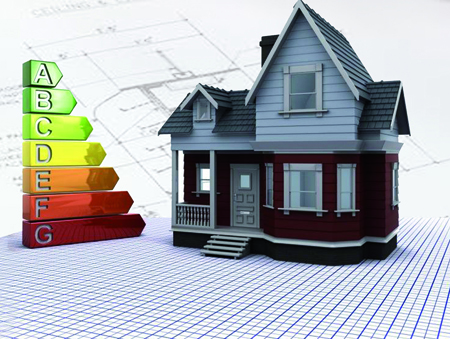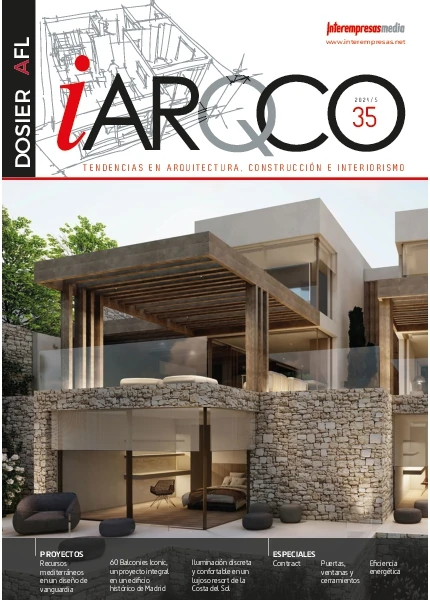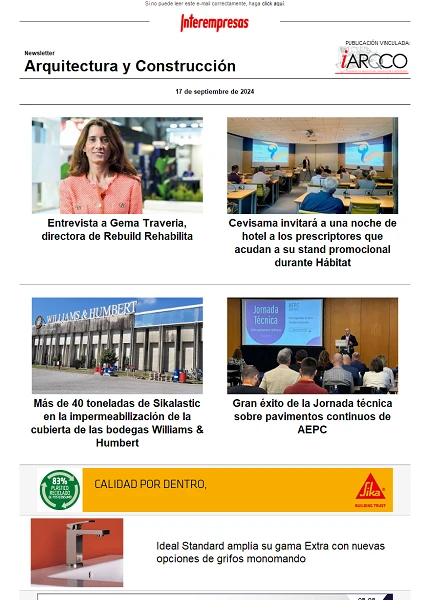Javier García Breva: "Spain is heading towards a State of energy poverty"
The Office of Javier Garcia Breva, whose owner is one of the main reference energy in our country, has organized a press conference in Madrid to assess the new law 8/2013 rehabilitation, regeneration and renewal urban (RRR) and denounce the contradiction posed by the publication of this regulation, focused on promoting energy efficiency measures, at the same time as from the Ministry of industry is in an order of tolls and a decree subsistence that discourage any action aimed at saving energy.
Less than a month after the publication of the law 8/2013 of rehabilitation, regeneration and urban renewal, a regulation that the own Javier García Breva qualifies as "good" for our country, because it represents an important advance in the rational use of energy, have made public some details of the order of tolls and the Decree of consumption, in which the Ministry of industry is currently workingThey discourage any initiative to reduce energy consumption.

From left to right: Africa Orenga, Director of imedia, and Javier García Breva, President of N2E, Business Coalition for a new model of energy business.
Confirm the intention of the Government to increase the fixed part of the receipt of the light up to 70% of the total, leaving the variable in just 30%, few will be consumers arising from now make works of rehabilitation or reform in their homes or shops when that investment just will save in your receipt of the light. What is known of the future order of tolls and the new decree of self-consumption, indicated by Javier García Breva, "severely penalizes saving energy" and makes that many possible actions cease to be bankable. In addition, it can lead to other serious risk to consumers, the increase in the fixed part of the receipts of light, are forced to reduce the contracted power to electrics, making less use of electricity in their homes, and causing what this specialist in energy policy qualifies as "State of energy poverty", something that until now was only typical of countries with a level of development far below the Spanish.
In addition, in the case of consumption, from the Office of Javier Garcia Breva, speaks even of "discriminatory treatment" by the Ministry of industry to renewable energies, with a regulation on the subject which can be "the more restrictive" all over the world and loading costs that do not apply to other types of energy sources on such initiatives. It also speaks of "an attack on individual rights of persons" with a decree that also goes clearly against the EU guidelines reduce the dependence of the members regarding the import of hydrocarbons, mainly of gas, which in the Spanish case are already between 4 and 5% of GDP (45 billion euros).
For all these reasons and as the cost of electricity one of the main concerns of the Spaniards (as just to highlight a recent survey), Javier García Breva shows his confidence in that the final regulations on tolls and subsistence from the Council of Ministers, remedy these aspects, clearly contrary to the objective of achieve greater energy efficiency.
Law 8/2013: rehabilitation and energy
These rules on tolls and self-consumption, dependent on the Ministry of industry, also run counter to the spirit that picks up the new law 8/2013 rehabilitation, regeneration and renewal urban (RRR) made from the Ministry of public works and published on June 26, which suggests that there is a clear lack of communication between both ministries.
A new and long-awaited law that completes the decrees of certification (RD 235/2013), RITE programs aid to housing (RD 233/2013) published a few months earlier, and that improves in relation to energy certification and reports of evaluation of buildings, assuming in addition an important advance in the rational use of energy as a major factor in the assessment of existing buildings. It assumes a decisive when it comes to having a normative instrument that focuses on facilitating the rehabilitation activities energy throughout the Park built, in the urbanization of public spaces and in the neighborhoods of the cities.
Already in the preamble of this new law are details that are worth highlighting. As Javier García Breva, there already refers to the rehabilitation policy to support economic recovery and employment, highlighting the difference that separates US from Europe in energy efficiency and the need to comply with the European 2020 targets on renewable energy, energy saving and emissions of CO2. Also recognizes the distance that separates us from the rest of Europe in what represents the rehabilitation in activity construction (13 percentage points lower than the European average) and the importance of reducing emissions in the diffuse sectors in order to achieve the European objective of removing between 80% and 95% emissions of CO2 by 2050.

The new law 8/2013 promotes energy efficiency in dwellings.
The preamble cited article 4 of the directive 2012/27/EU energy efficiency which establishes the commitment of Governments to approve a national rehabilitation strategy around the Park's buildings, both public and private, in April 2014 and it is demonstrates its importance for Spain with a park where 58% of the 25 million houses built before 1980 and that 6 million have more than 50 years old. These circumstances are also timely to consider rehabilitation at the level of neighborhoods with comprehensive policies to achieve its energy self-sufficiency in the context of the objectives of Directive 2010/31/EU energy performance of buildings to create green jobs through renewable energy and energy conservation as elements of transformation of the production model.
The three objectives of the Act, which are aligned with the directive 2010/31/EU, materialize on enhancing the rehabilitation of buildings making it viable and possible, create a regulatory framework for the revival of the construction industry through the rehabilitation and bring our regulatory framework to the European on energy saving and energy poverty.
Report of evaluation of buildings and energy certification
Law 8/2013 improve the scope and efficiency of the energy certification regulated in RD 235/2013 through the new figure of the assessment report of buildings (IEE) that replaces the previous inspection technique of buildings (ITE). The EIA will include the energy certification of the building with the recommendations for improvement; in accordance with regional and municipal regulations you can fill the need to execute the recommendations or correct the deficiencies observed. The AA CC should register both the EIA as the rectification of deficiencies and non-compliance will be considered urban development infraction with the effects that set the standards.
As well as in the RD 235/2013 is set mandatory energy certification for all buildings under construction, sale or rental, the EIA should be owners of residential buildings of collective housing with more than 50 years old in the following 5 years, buildings that intend to apply for State aid and the other buildings as determined by regional or municipal legislation. The report may be signed both by inspection entities registered in the regional administration as by competent technicians that are considered to be those that are enabled for the drafting of projects or address and execution of construction works, with the exception of the buildings of the public administrations which will do so through its technical services.
In the 3rd and 4th additional provisions establishing infringements and sanctions regime of energy certification of buildings with the observation that the statement and resolution of the disciplinary proceedings will be up to the competent bodies of the autonomous communities. Offences are classified as very serious, major and minor with the main objective of preventing distortion of the energy certification information. The graduation of sanctions will go from 300 euros to 6,000 euros and may be longer depending on the profits earned by the infringer.

Rehabilitation is a revival of our economy and the employment factor.
Proceedings of urban rehabilitation, regeneration and renewal
The performances will include renovation of existing buildings in situation of degradation or failure in basic habitability requirements and works of regeneration and renewal of the development of the public space that affects both buildings and urban fabric, including new building instead of previously demolished buildings. They must be performances by character integrated through social, environmental and economic measures framed within an overall strategy.
Depending on the scope of the proceedings will be the owners, the owners or housing cooperatives or public administrations communities who have the obligation to carry out the works included in each performance and the capacity for initiative to carry out. Responsible for public administrations more specifically to address situations of failure or degradation of neighbourhoods or homogeneous urban sets priority measures to eliminate situations of infrahouse and promote the rational use of energy in these cases.
Among the basic rules that are established to manage and execute these actions is facilitated by limits on the transfer of land and rescue of capital gains, the execution of works for the improvement of energy efficiency in the spaces that get a reduction of 30% of the energy demand for heating or cooling through the building envelope improvements, devices attached bioclimatic, centralised energy installations and integration of renewable energy sources that will reduce non-renewable energy consumption by 30%.
These actions will require a prior memory that will ensure its viability and economic, in the case of energy efficiency, which can generate income to finance most of the cost of rehabilitation. Eligible energy service companies that assume the commitment to integrate into management by financing part of it through the savings in time, in a clear allusion to energy performance contracts for this analysis.
To promote these actions in the RD 233/2013 of April 5, the Government approved a list of programmes amounting to 2.421 M which comprise aid for rehabilitation of buildings up to 11,000 by housing, for the rehabilitation of neighborhoods by 40% of the budget and helps to hire up to 40%, as well as financing of the ICO by 1.000 M for rehabilitation and the Idae for energy efficiency in buildings by 100 M and buying credits for reduction of CO2 emissions in the building sector.

Inconsistencies with the European standards and the Government's energy policy
In view of this justification of the law 8/2013 for Javier García Breva draw attention to some inconsistencies with the own European directives cited in support and the energy policy of the Government. When we look at the articles of the law did not appear any provision which transposed into our legal system, even partially, any article of the European directives that are valued as well in its preamble. Aside that 2010/31/EU energy performance of buildings was his deadline for transposition by January 2013 and 2012/27/EU energy efficiency is on transposition deadline until June 2014, two directives establish, within the European framework, obligations on Governments to develop national energy efficiency action plans in 2014, plans for long-term rehabilitation of all park buildings, plans of buildings of nearly zero energy consumption or plans of rehabilitation of 3% per year of the surface of public buildings.
There are other measures that decisively affect the energy efficiency of buildings such as those referring to energy audits, reduction each year of 1.5% of the turnover of power to final consumers, counters for the net balance or access to energy services that could have been included in this law and closer, so yes, to the European regulatory framework for energy efficiency of buildings. Missed the opportunity to move more quickly in the European 2020 targets with a law that not only define the framework, but also its development with concrete plans to mobilize investments, applying the principles described in the preamble and give effective aid programs approved in April. The difference between the law 8/2013 and the European energy efficiency policy remains considerable.
The common goals of public policies for a more sustainable, efficient and competitive urban environment and, among them, in his letter h are described in article 3 of the law 8/2013) "Prioritize renewable energy sources against the use of fossil energy sources and combat energy poverty with measures in favour of efficiency and energy saving". This statement is inconsistent with the policy agreed by the Government that prevents the authorization of new renewable facilities, which promotes and encourages the use of the gas in the heating systems of buildings indefinitely and that his vote against the directive 2012/27/EU of energy efficiency, in October 2012, noted as one of the reasons that the increased energy efficiency would be an obstacle to the revival of the of the construction sector in Spain. Definitely, the contradiction of this law with the Government's energy policy remains credibility to their energy saving goals.

Stimuli to the energetic efficiency
The European Commission in his report on ‘financial Backrest to the energetic efficiency of buildings' of 18 April 2013 describes the distinct forms to stimulate the investment in energetic efficiency and fulfil the main aim of the Directive 2012/27/EU that in his article 4 orders that the States members will establish for April of 2014 a strategy on a long-term basis for movilizar investments in the rehabilitation of the national park of buildings, so many publics like private.
The instruments to achieve this mobilisation of destined resources to the saving of power in the buildings will develop through three big initiatives:
1.- A regulatory frame defined already in the Directives 2010/31/EU of energetic efficiency of buildings (DEEE) and 2012/27/EU of energetic efficiency (DEE) that incorporate no only a catalogue of measures and concrete plans of energetic efficiency but also a vision on a long-term basis and a commitment in favour of the saving of power in a marked stage by the increasing and unsustainable bill of the energetic imports. The Commission goes to effect a narrow follow-up to guarantee the fulfillment of the regulatory frame of the EU and his incorporation to the national legislations.
2.- Improve the access to the European financials in the next financial frame 2014-2020 increasing the resources of cohesion allocated to the politics of reduction of broadcasts and reserving in scoop 20% of the bottoms Feder to politics of energetic efficiency and renewable energies. In this sense, the States members will have to ensure that the regional operative programs of the Feder do an optimum use of the destined financials to energetic efficiency and to the mobilisation of the necessary investments for the plans of rehabilitation of the park of planned buildings in the DEE. The article 20 of the DEE establishes the creation of a national Bottom of energetic efficiency to back the projects of energetic efficiency. The Commission will develop along 2013 the guidelines of selection and evaluation of projects of energetic efficiency. According to the estimates of Javier García Breva, Spain can receive of the European bottoms until 4.000 M for energetic efficiency during the next seven years. The quantity can be greater or lower in function of the commitment and of the capacities of all the public servicys for the development and execution of projects of energetic saving.
3.- Elimination of barriers that prevent the implantation of the energetic efficiency of buildings. The DEE orders to the States members evaluate and take measures to delete the statutory barriers and no statutory that prevent the access to the energetic services and to the development of the market of the companies of energetic services through the agreements of energetic performance and financials by third by means of a frame of energetic certification more vinculante. Through the program Horizon 2020 will assign 6.100 M to back the destined initiatives to delete the normative barriers, financial and of market to the energetic innovation and the Commission will launch a campaign of promotion of the markets of energetic services through the public collaboration-private centred in the local entities and the initiative ‘Pact between mayors'.



































































































